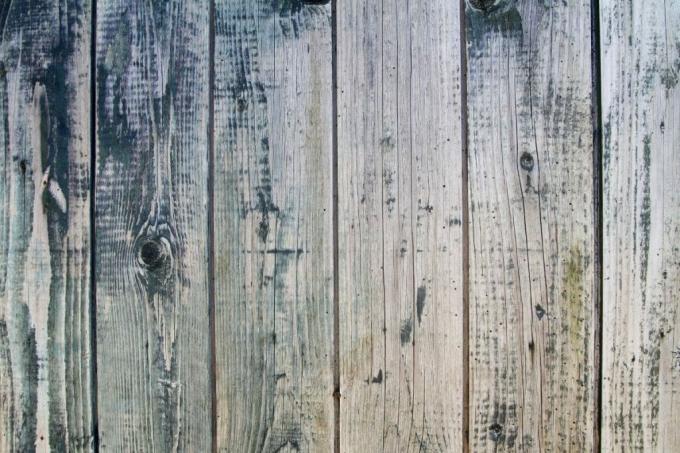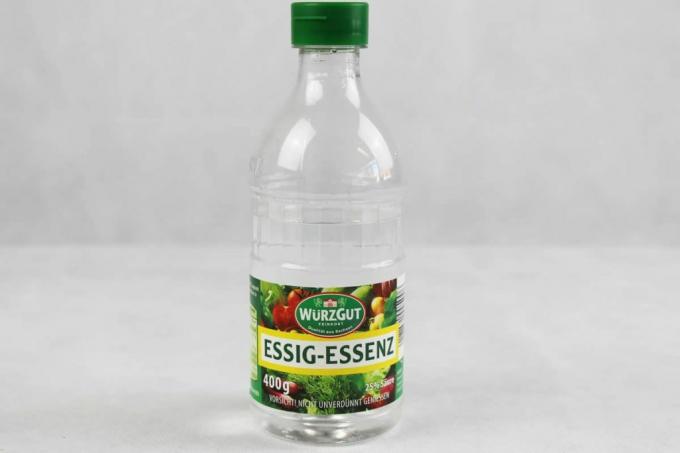
table of contents
- causes
- prevention
- Utensils & means
- Protective measures & means
- Superficial infestation
- Treat deeper infestations
- frequently asked Questions
Black mold stains on the wood are not only visually annoying, they also pose a health risk. Aids, instructions and preventive measures can be found here.
In a nutshell
- Sanding is often required
- Chlorine, vinegar essence and fungicide are possible aids
- Stains are caused by mold
- Humidity plays a crucial role
- sustainable prevention is easier than removal
causes
Black mold stains can show up on wooden furniture both indoors and outdoors. They occur more frequently outdoors than indoors, as more favorable factors occur here. These include:
- frost
- rain
- snow
- Sun or UV radiation
The material can become brittle as a result and moisture or liquid can penetrate. Appropriate protection is therefore required. Otherwise the wooden material acts as an ideal breeding ground for mold. It is precisely this that causes black mold stains to appear. In addition to the causes already mentioned, other favorable factors can also be considered. Including, for example, soiling such as:
- Leaves and needles
- Pollen and petals
- other dirt
- Bird droppings
All of these substances ensure that the mold spores can penetrate deeper into the wood and initially spread here unnoticed. This leads to damage that is only visible through foxing.

prevention
It is said that prevention is better than cure. This also applies to mold stains on wooden furniture. There are some measures that can be taken to prevent them from occurring. These include:
-
choose the right type of wood: Soft types of wood such as spruce and pine are more susceptible to mold and therefore not suitable for outdoor use. Hardwoods such as teak, Douglas fir, oak and larch, on the other hand, are less sensitive and are resistant to mold. Especially outside or in damp areas, the selection should therefore be made carefully.
-
ventilate: Appropriate ventilation and sufficient distance from walls and other furniture is an essential prerequisite for avoiding mold stains. This is the only way the wood surface can dry properly. Correct ventilation is just as important. Therefore, it should be warmer inside than outside. Otherwise, warm moist air can penetrate into the cooler room and precipitate on the surfaces.
-
suitable protective equipment use: Lacquer, glaze, wax and oil can be used to protect the natural material. These remedies must be applied on a regular basis to remain effective. This is especially true for outdoors.
- subordinate or cover: The less temperature fluctuations and the less precipitation the wood is exposed to, the lower the risk of damage and mold.
Utensils & means
If black mold stains have already appeared, appropriate means must be used. Suitable for combating mold are:
- Chlorine cleaner
- Vinegar essence
- Fungicides
You will need:
- bucket
- a sander and sandpaper
- paint brush
- spray bottle
- water

Protective measures & means
Dealing with an appropriate tool and the mold itself can endanger your health. The eyes, respiratory tract and mucous membranes are particularly sensitive to this. Possible complaints are:
- reddened, watery eyes
- increased secretion production
- cough
- headache
- nausea
The right safety precautions are therefore crucial. You will need:
- good ventilation
- gloves
- safety goggles
- Protective mask
Superficial infestation
In order for the black mold stains to be removed from the natural material, several steps are required. It refers to:
-
Let furniture dry: The wooden furniture must be completely dry before it is treated. Otherwise the mold can spread again in a short time despite all efforts. Heat radiators, for example, can be used for this purpose.
-
Use detergent: Vinegar essence, chlorine or fungicide are often sufficient for small and demarcated stains. They can be applied with a brush or sprayed on. It is important that the agent can be absorbed well and get into every crack.
- Wipe off: After an appropriate exposure time of about 30 to 60 minutes, the stain is sprayed again and then wiped off. It is best to use cellulose for this, which you can dispose of in the household waste. Because the ingested spores may not have been completely killed and could therefore pose a health risk.

Note: If the stains have not disappeared afterwards, the application must be repeated. This can be necessary several times.
Treat deeper infestations
If the mold has already penetrated deeper layers of the wood, simply soaking and wiping it off is no longer enough. A little more is then required for the removal. The following guide shows how it works.
-
Let furniture dry: The affected piece of furniture must be completely dry. Again, it is advisable to use a radiant heater, for example. A construction dryer is ideal.
-
Sanding: The affected layers are removed manually with sandpaper or a sander. To avoid unevenness, the surface should be checked again and again with a spirit level. In addition, of course, the entire surface should be included in the sanding process.
-
Apply means: Chlorine, vinegar or fungicide can be used. The wood can be soaked with it.
- Remove excess liquid: After the exposure time, you should wipe off any excess liquid. Cellulose is best suited for this, as it is absorbent and can be easily disposed of.
If black mold stains appear again, you must repeat the application. Only in very severe cases is it better to dispose of the wood. Otherwise, serious consequences can arise, especially indoors.

Tip: Then dispose of the sandpaper. Because in this there is not only dust but also mold spores. If they are used again, these could be distributed.
frequently asked Questions
Covers and tarpaulins are often used to cover outdoor furniture. On the one hand, these form protection against direct contact with precipitation and protect against UV radiation. On the other hand, they can also trap existing moisture and thus encourage mold. Storage in a dry and frost-free room is therefore better.
Yes, that makes sense in any case. This removes dirt and thus also spores, which lowers the risk of a mold infestation.
There is no general answer to that. Because the frequency depends on various factors. These include the type of agent and the influences to which the piece of furniture or the terrace, for example, are exposed. Lacquer therefore usually lasts longer than glaze, oil or wax. For wood indoors, however, these can be completely sufficient and, due to their properties, even contribute to a pleasant room climate. When making your selection, always pay attention to the suitability and the manufacturer's information.



